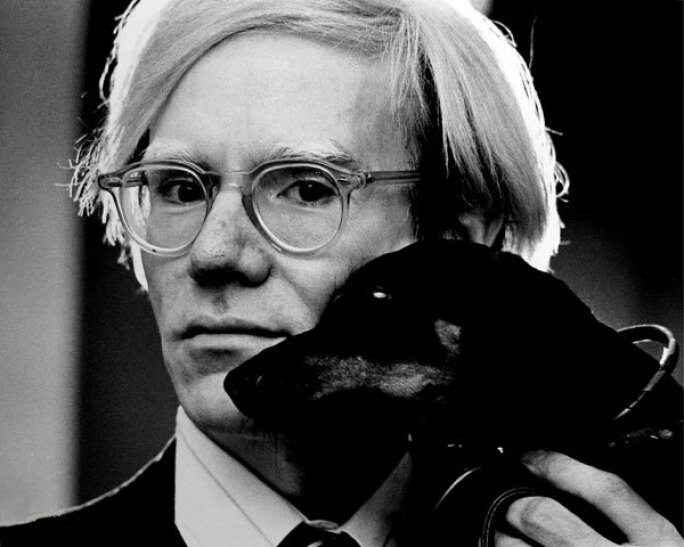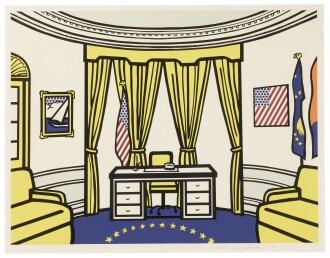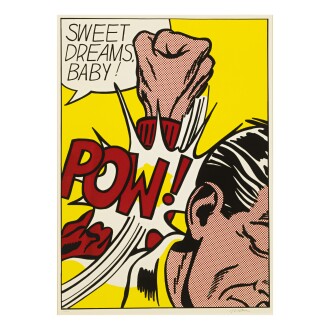About Pop Art
What is Pop Art?

Pop Art describes an art movement that emerged in the 1950s and ‘60s in Britain and America, so named for its appropriation of imagery and techniques from popular and commercial culture. Representing a radical departure from the prevailing approaches to “high art,” pop artists introduced the everyday and accessible – advertisements, product packaging, pop music, comic books and Hollywood movies – into the vernacular of the fine arts. The movement first originated in London in the 1950s, where the Independent Group, an important precursor to British Pop Art, began to reflect on the accomplishments and excesses of American popular culture in the post-War years. In the States, Pop Art rose to prominence against the backdrop of the enormous political and cultural shifts of the 1960s. Looking to the readymades of Marcel Duchamp and the Neo-Dadaism of Jasper Johns and Robert Rauschenberg, emerging Pop Artists rejected the Abstract Expressionist style that had dominated the art scene of the 1950s. Favoring hard edges over painterly looseness, mundane imagery over individualistic abstraction, irony and wit over earnest expression, and mass production over heroic methods, the Pop Artists pioneered a vital shift in the trajectory of 20th century art.
Characteristics and Style of Pop Art

In 1957, Richard Hamilton described the style, writing: “Pop art is: popular, transient, expendable, low-cost, mass-produced, young, witty, sexy, gimmicky, glamorous and big business.” Often employing mechanical or commercial techniques such as silk-screening, Pop Art uses repetition and mass production to subvert ideas of artistic originality and value. Equally important, Pop Art’s chosen subject matter— common household objects, consumer products, and images from popular media— challenge the elitism of “high art”.
While British Pop Art, in which American pop culture is viewed from a distance, exhibits more academic tendencies, American Pop Art is characterized by its immediacy and aggression, with bold colors and hard edges emphasizing a sense of ironic detachment.
What is the legacy of Pop Art?

Pop Art’s introduction of “low” subject matter and its novel techniques of production and presentation can be understood as a pivotal turning point in 20th century art, and one of the first manifestations of postmodernism. Breaking from the elitism of Abstract Expressionism, this new, more democratic mode of expression relied on accessible iconography and shared cultural reference points. With an influence extending beyond the US and Britain, Pop Art reflected an international zeitgeist; contemporary counterparts sprung up in Germany, France and Japan, and by the early 1970s, in Socialist Russia. Beginning in the 1980s, Neo-pop artists like Keith Haring, Jeff Koons and Takashi Murakami would revive the ideas of Pop Art in a postmodern context.
Timeline & History of Pop Art
 1947Eduardo Paolozzi creates the collage I Was A Rich Man’s Plaything using cuttings from American magazines, which includes the word “Pop!” in its design. The work is considered a seminal piece of proto-Pop Art.
1947Eduardo Paolozzi creates the collage I Was A Rich Man’s Plaything using cuttings from American magazines, which includes the word “Pop!” in its design. The work is considered a seminal piece of proto-Pop Art.
(left) Sir Eduardo Paolozzi, I was a Rich Man’s Plaything, 1947 from Ten Collages from BUNK. Presented by the artist 1971. © The estate of Eduardo Paolozzi 1958Critic Lawrence Alloway writes an essay titled “The Arts and The Mass Media,” popularizing pop art concepts. Alloway is sometimes credited with coining the term “pop art,” although there is evidence of its use as early as 1954.
1958Critic Lawrence Alloway writes an essay titled “The Arts and The Mass Media,” popularizing pop art concepts. Alloway is sometimes credited with coining the term “pop art,” although there is evidence of its use as early as 1954.
(left) Portrait of British art critic and curator of the Guggenheim Museum Lawrence Alloway as he poses in the museum, New York, New York, January 28, 1964. Photo by Fred W. McDarrah/Getty Images 1961David Hockney, Peter Blake and others participate in the Young Contemporaries exhibition, bringing Pop Art to the attention of the general British public.
1961David Hockney, Peter Blake and others participate in the Young Contemporaries exhibition, bringing Pop Art to the attention of the general British public.
(left) David Hockney, Different Kinds of Water Pouring into a Swimming Pool, Santa Monica, 1965. Sold £2,715,000 1962Andy Warhol establishes his New York City studio, the Factory. He adopts photographic silkscreening, allowing him to easily reproduce images appropriated from popular culture, and begins his series of celebrity portraits. This same year, he has his first solo show at Ferus Gallery in Los Angeles, where he shows his series of 32 Campbell’s Soup Cans.
1962Andy Warhol establishes his New York City studio, the Factory. He adopts photographic silkscreening, allowing him to easily reproduce images appropriated from popular culture, and begins his series of celebrity portraits. This same year, he has his first solo show at Ferus Gallery in Los Angeles, where he shows his series of 32 Campbell’s Soup Cans.
(left) The Decker Building, the second location of the Factory, 33 Union Square West, NYC 1962The Museum of Modern Art in New York organizes a Symposium on Pop Art, marking the first use of the term in the US.
1962The Museum of Modern Art in New York organizes a Symposium on Pop Art, marking the first use of the term in the US.
(left) The 1962 press release for the Museum of Modern Art's Symposium on Pop Art. Courtesy: MoMA 1963The Guggenheim opens its landmark Pop Art show, Six Painters and the Object, curated by Alloway.
1963The Guggenheim opens its landmark Pop Art show, Six Painters and the Object, curated by Alloway.
(left) The cover from the catalouge for the 1963 exhibition Six painters and the object, by Lawrence Alloway, at the Solomon R. Guggenheim Museum. Publication date 1963. Digitizing sponsor: Solomon R. Guggenheim Museum Library and Archives. Contributor: Solomon R. Guggenheim Museum 1964The Bianchini Gallery in New York mounts The American Supermarket exhibition. Presented as a small supermarket environment, the exhibition is a collaboration of prominent pop artists, including Warhol, Lichtenstein and Oldenburg.
1964The Bianchini Gallery in New York mounts The American Supermarket exhibition. Presented as a small supermarket environment, the exhibition is a collaboration of prominent pop artists, including Warhol, Lichtenstein and Oldenburg.
(left) Andy Warhol, Flowers, 1964. Sold $5,674,250
Artists
Who are the Pop Artists?
Pop Art originated in the mid-1950s with members of the Independent Group, notably Richard Hamilton and Eduardo Paolozzi. A later wave of artists, including David Hockney and Peter Blake, were included in the seminal Young Contemporaries exhibition of 1961 and would take up the mantle of British Pop Art.
Although the movement first emerged in Britain, the London-based Pop Artists were soon overshadowed by their American counterparts. Among them, Andy Warhol is certainly the most influential figure. Beyond his experiments in silkscreening, photography, film, and sculpture, Warhol translated the ethos of Pop Art to an entire lifestyle. Others are nearly as iconic: Roy Lichtenstein, best known for his comic book-style paintings, defined the premise of Pop Art through parody; Claes Oldenburg’s oversized replicas of everyday objects offer a playful commentary on consumer culture.
Pop Artists
The Pop Artists at Auction
The Pop Artists at Auction
Have Something to Sell?
Have Something to Sell?
Get Started



























